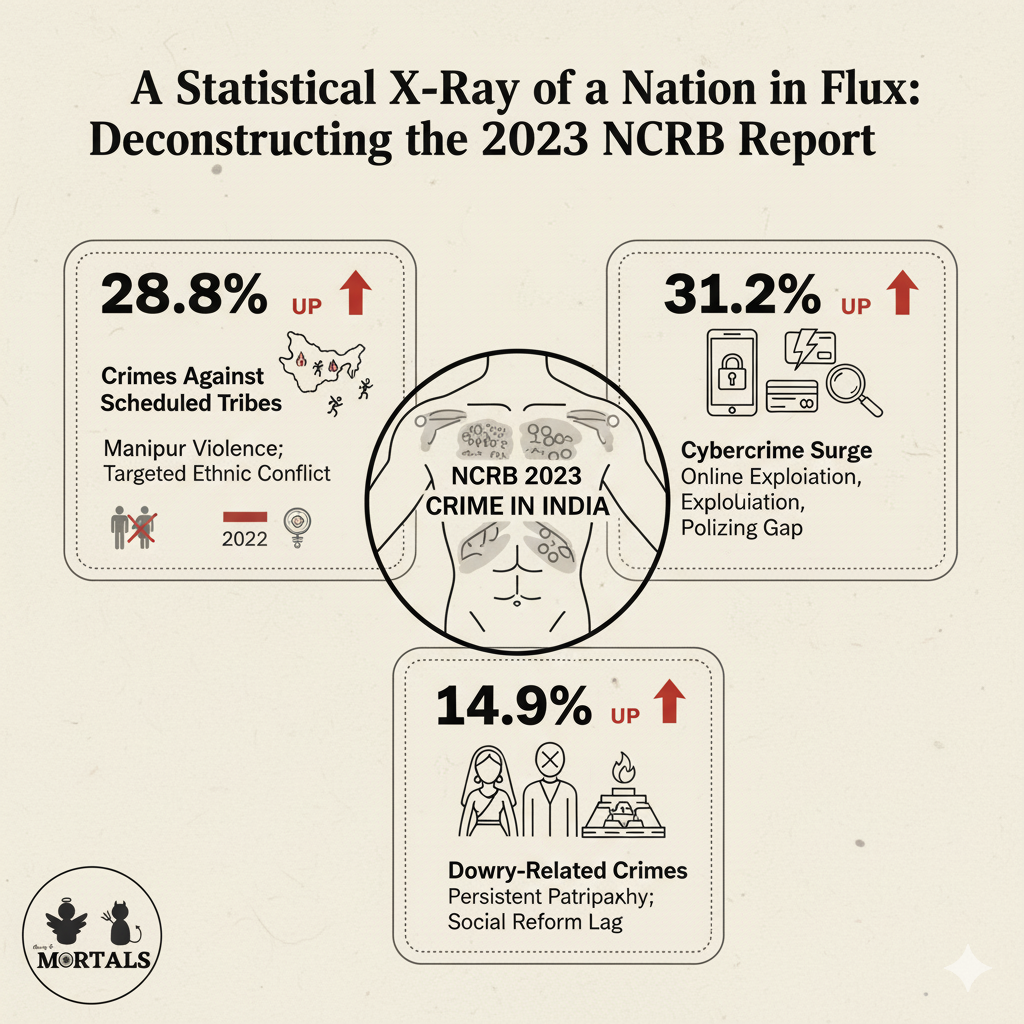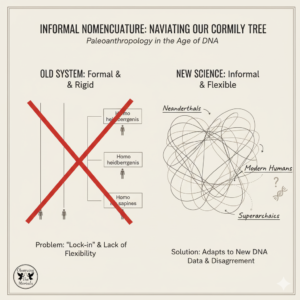Every year, the National Crime Records Bureau (NCRB) releases its “Crime in India” report, which functions like a statistical health check-up for the nation. It is a dense, often grim, collection of numbers. But beneath the tables and charts lies a powerful story about the state of our society. The latest report for 2023 is a study in contrasts: a welcome drop in murders is completely overshadowed by two alarming surges—a massive spike in crimes against Scheduled Tribes and an explosion in cybercrime. This case study delves into these “three telling numbers” to understand what this official data reveals about the deep-seated conflicts and rapid, disorienting changes shaping modern India.
The Information Box
Syllabus Connection:
- Paper 2: Chapter 6.1 (Problems of Tribal Communities: Atrocities), Chapter 3 (Social Problems: Dowry), Chapter 8 (Social Change: Impact of Media)
- Paper 1: Chapter 4 (Political Anthropology: Conflict, State Failure), Chapter 1.7 (Digital Anthropology)
- GS-2/3: Social Justice, Governance, Internal Security
Key Concepts/Tags:
- NCRB Data, Crimes Against STs, Manipur Violence, Cybercrime, Governance Failure, Social Indicators
The Setting: Who, What, Where?
This case study is an analysis of the key findings from the “Crime in India” report for 2023, released by the National Crime Records Bureau (NCRB), a central government agency. The report is a pan-Indian statistical compilation of crimes registered by the police. The most dramatic and significant data point emerges from the state of Manipur, where the ethnic conflict that began in May 2023 has had a devastating and statistically visible impact on the state’s tribal population.
The Core Argument: Why This Study Matters
The NCRB report is not just a list of crimes; it is an official, quantitative diagnosis of the most urgent social pathologies facing the nation.
- The Manipur Tragedy, Quantified: The most shocking finding is the staggering 28.8% nationwide surge in crimes against Scheduled Tribes (STs). The report makes it clear that this is not a widespread national trend but a statistical anomaly driven almost entirely by a single, catastrophic event: the ethnic violence in Manipur. The state went from recording just one case against STs in 2022 to 3,399 in 2023, providing an undeniable, official metric of the scale of the targeted violence against the tribal communities there.
- The Digital Dark Side: The report confirms a 31.2% increase in cybercrimes, particularly financial fraud and sexual exploitation. This is not just a law and order problem; it is a direct social consequence of India’s rapid and often unregulated digitalization. It reflects the growing vulnerability of a population that is adopting digital finance and social media at a faster pace than the state’s capacity to police these new virtual spaces.
- The Stubborn Persistence of Patriarchy: While the overall rate of crimes against women saw only a modest 0.4% rise, a deeper look reveals a more disturbing trend: a 14.9% spike in dowry-related crimes. This is a powerful anthropological indicator that even as India modernizes, this deeply entrenched and violent patriarchal practice is not fading away; in some areas, it may even be getting worse.
The Anthropologist’s Gaze: A Critical Perspective
An anthropological reading of the data moves beyond the numbers to the social processes they represent.
- The Iceberg of Under-reporting: An anthropologist would immediately apply a critical lens to the data itself, remembering that the NCRB records reported crimes, not actual crimes. This is the “iceberg” problem. In a conflict zone like Manipur, or in deeply personal crimes like dowry harassment and child abuse, the number of cases that are never reported to the police is likely immense. The horrifying official statistics are, in all probability, a significant undercount of the true scale of the violence.
- Data as a Mirror to Social Fault Lines: The report is a statistical mirror that reflects the primary social fault lines of contemporary India. The three major trends—ethnic conflict, the risks of unregulated technology, and persistent patriarchal violence—are not separate issues. They are the defining challenges of a nation grappling with the tensions between its diverse communities, its rapid technological transformation, and its slow pace of social reform.
- The Paradox of the “Known Offender”: A chilling and profoundly anthropological insight is the finding that in 96% of cases of crimes against children, the offender was known to the victim. This statistic powerfully deconstructs the “stranger danger” myth that society often perpetuates. It reveals that the most dangerous space for a child is often not the dark alley, but the familiar circle of family, neighbors, and supposed guardians. This points to a deep crisis within the most fundamental unit of society itself.
The Exam Angle: How to Use This in Your Mains Answer
- Types of Questions Where It can be Used:
- “Analyze the major problems faced by tribal communities in post-Independence India, with a focus on atrocities.”
- “The impact of globalization and digitalization has been a mixed one for Indian society. Discuss.”
- GS-2 (Social Justice/Governance): “Official data is a crucial tool for assessing the state of vulnerable sections. Analyze with recent examples.”
- Model Integration:
- On Tribal Problems (Paper 2): “The extreme vulnerability of tribal communities to ethnic conflict is starkly quantified by the latest NCRB data. The 2023 report shows a nearly 29% national surge in crimes against STs, a statistical anomaly almost entirely driven by the 3,399 cases registered during the Manipur violence, providing official evidence of the targeted nature of the conflict.”
- On Social Change (GS-1/Anthro): “The rapid and often unregulated pace of digitalization in India has created new social vulnerabilities, a trend confirmed by the 2023 NCRB report which recorded a 31.2% increase in cybercrimes. This highlights the growing gap between technological adoption and the state’s capacity for regulation and policing.”
- For GS-2 (Governance): “Official reports like the NCRB’s ‘Crime in India’ are vital for evidence-based policymaking. The 2023 report, for instance, flags a 14.9% spike in dowry-related crimes, signaling to the government that existing legal and social interventions against this persistent patriarchal practice are proving insufficient and require urgent strengthening.”
Observer’s Take
The NCRB report is a somber but essential document. It is a statistical x-ray of our society, revealing both the healing of old wounds and the festering of new ones. While the decrease in murders offers a glimmer of hope, it is overshadowed by the dark clouds of targeted ethnic violence, a burgeoning digital underworld, and the stubborn persistence of patriarchal crimes. These numbers are more than just data points; each one is a record of a human tragedy, a governance failure, and a tear in the social fabric. The true value of this report lies not in the shock it generates, but in its potential to serve as an undeniable call to action—for more effective governance, deeper social reform, and a more just and secure future for all.





